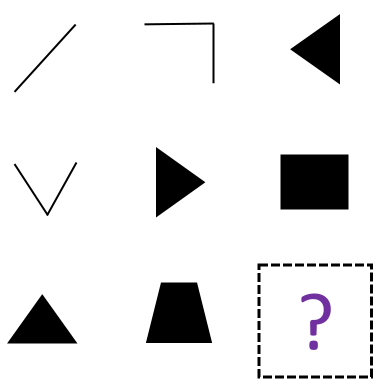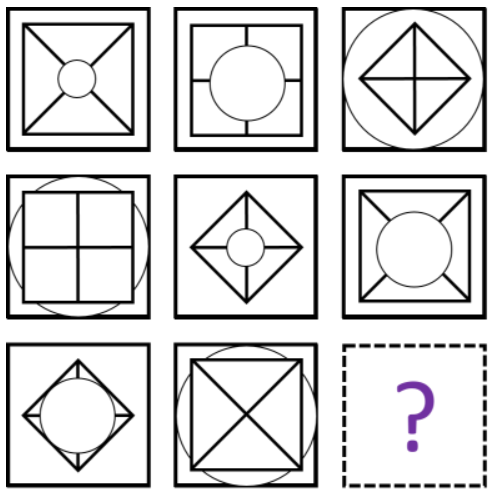 Free Matrigma Test Practice Guide 2025
Free Matrigma Test Practice Guide 2025
Matrigma is a renowned online cognitive ability assessment designed to evaluate yout overall reasoning skills. This non-verbal test is highly versatile and can be readily adapted for individuals of various linguistic backgrounds, and for a variety of positions.
Our Matrigma test PrepPack includes the following material that will help you ace the test:
- Video tutorial and study guide - To help you understand the test format and question difficulty. As well as providing you with expert tips to follow the best answering strategy.
- Matrigma test simulations - Familiarize yourself with the test and practice as many times as you need. Our pack includes thorough explanations and over 200 questions to practice.
- Extra practice - Additional practice that will help you further improve your questions-solving skills in inductive reasoning.
- Matrigma Practice Tests
2 full simulations
Basic drill - Matrigma Test Study Guide
- Extra Practice
3 matrices practice tests
4 Raven matrices tests
11 inductive reasoning - Next in series - Video Tutorial
Matrigma Test FAQ
The Matrigma test is a widely recognized pre-employment assessment that sheds light on your critical thinking and learning potential. Through a series of online challenges, it evaluates your ability to solve problems, analyze information, and draw sound conclusions - skills that are highly sought-after by employers across various industries.
Acing the Matrigma test involves both preparation and smart test-taking tactics. Beforehand, practice abstract reasoning tests to familiarize yourself with the logic and patterns used. Understanding the format, with its time constraints, will also help you manage the actual test effectively.
During the test, quickly scan the matrix to identify any initial patterns. If you're stuck, analyze individual figures, considering their shape, color, and other features. Remember, the rule might apply to rows, columns, or both, and order might not matter. Allocate one minute per question, and if you get stuck, move on and revisit it later if time allows. While there's no penalty for wrong answers, guess strategically by eliminating obvious incorrect options. By combining preparation and these strategies, you'll be well-equipped to succeed on the Matrigma test.
Defining a "good" Matrigma test score can be tricky as employers receive your results categorized as "low," "average," or "high" without specific numerical values. However, generally, a score in the "high" category (typically considered 7-10 out of 10) is seen as very strong, indicating excellent critical thinking and problem-solving skills. This would be ideal for many positions and could put you ahead of other candidates. While an "average" score (3-6) suggests you possess the necessary abilities for most roles, a "high" score would demonstrate exceptional potential and could be highly beneficial in your job application.
The adaptive Matrigma test version has a 12-minute time limit, where most people answer 20-25 questions.
Although our practice tests are in the classic version, since both versions of the Matrigma use the same questions and logic, you will find our practice tests and study guides very beneficial to improve your chances of in succeeding the Matrigma.
What Is the Matrigma Test?
Matrigma is a renowned cognitive ability test designed to evaluate your overall critical reasoning and learning skills. The test is an online pre-employment assessment that helps employers examine your ability to solve problems and draw conclusions, which is crucial for almost any position.
Find more cognitive ability practice for tests such as the PI Cognitive Assesment, Revelian Test, and the CCAT Aptitude Test.
The Matrigma test is composed of matrices and is essentially founded on the famous Raven matrices, the classic matrix test upon which all GMA (General Mental Ability) tests are based. It is considered by many to be the truest form of GMA.
Watch the following Matrigma Test Practice Video for answering tips and explanations.
Matrigma Test Questions & Answers
1. Choose the shape that best fits the following pattern.

2. Choose the shape that best fits the following pattern.

Find more practice questions on our Free Raven's Matrice Test page. Other tests also include similar questions, such as the SHL Inductive Reasoning Test, and the Cubiks Test.
Matrigma Test Versions
There are two versions of the Matrigma test:
- Classic Matrigma Test: This is the common version of the test. There are a total of 35 questions on this test that need to be answered within a 40-minute time limit. The difficulty of the questions increases as you continue to progress throughout the test.
- Adaptive Matrigma (Matrigma 2): This is the newer version of the original Matrigma test making it less common to encounter. On this version of the test, the time limit has been dwindled to 12 minutes leaving only 1 minute to answer each question. Since this version is adaptive, the level of difficulty for the next question depends on the result of the previous question. This means that for each question that you answer correctly, the next question will be even more difficult than the one before. Similarly, if you answer any of the questions incorrectly, the next question will decrease in difficulty.
Matrigma Test Results
Matrigma test scores are confidential and reported in three categories: low, average, and high. While the exact scoring method is not public knowledge, a score of 7 or higher is generally considered strong, and employers typically look for scores in the above-average range (which falls between 7 and 10).
The average score for the classic version (35 questions in 40 minutes) is 18 correct answers, and answering half the questions correctly usually translates to an average score.
More Matrigma Test Tips
- Start by quickly scanning the matrix, both the rows and the columns, to see if anything draws your attention.
- If the rule is not immediately discernible, examine the figures in the matrix carefully, focusing on one characteristic at a time. Remember that the rule might operate on a figure's shape, colour, alignment, motion, and quantity, among other features.
- The rule can operate in the matrix’s rows, columns, or both, and it might not necessarily give importance to the order of the figures.
- Give yourself one minute per question, if you can't solve the question in this amount of time, move on to the next one. Acting this way will leave you time to go back and answer questions you may have skipped.
- Don’t leave any questions unsolved. If you are not sure what the answer is, guess! There is no penalty for wrong answers.



